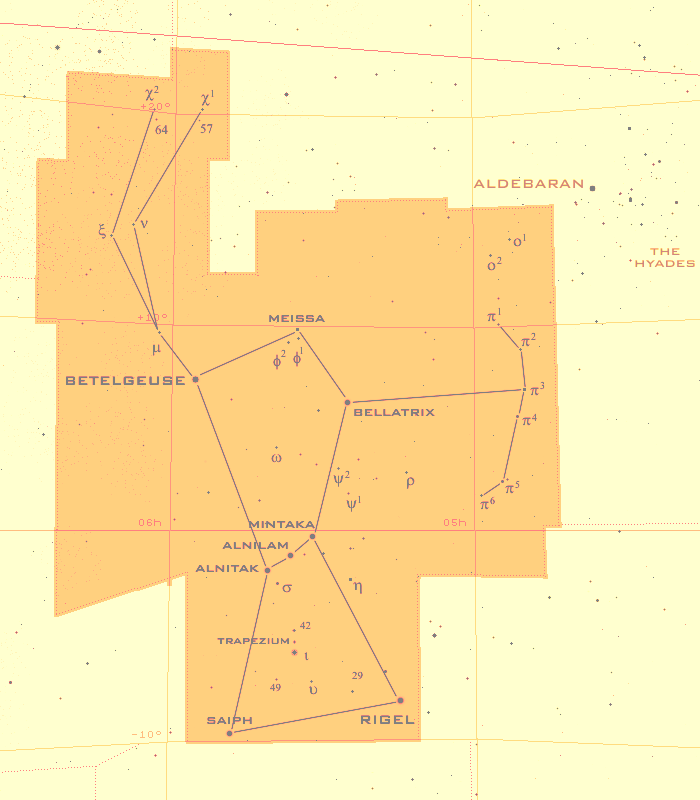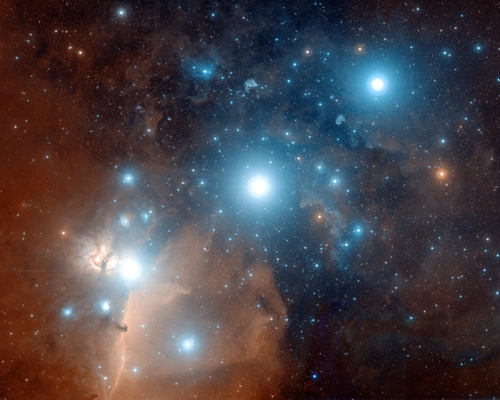Orion Correlation Theory
it made mainstream media
|
aka: "OCT" ...in such
concentric circles...
|
|
|
above pic altered from
my own site Spacedog
|
|
|
the basic general idea is
that the pyramids of Giza
somehow conform or align
to the stars of Orion's Belt...
and the correlation is obvious
(the resemblance is remarkable)
...but because it's not exact...
there's been a bit o controversy
|
|
|
the original work of Robert Bauval
is what more or less started it all
with The Orion Mystery back in 1994
|
and then Graham Hancock got into it
with Fingerprints of the Gods, etc
|
...you've seen these guys on TV...
(it's almost a counterculture, now)
but these guys aren't "pyramidiots"
they're investigating *responsibly*
...they know the difference between
facts and supposition more than the
accepted, established Egyptologists
...seem to (so much of the time)...
|
|
|
|
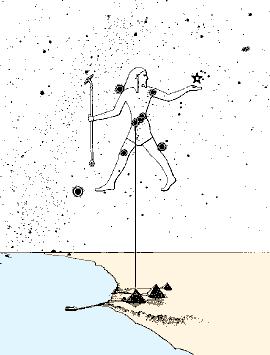 |
classic OCT iconography
...from... various works...
of the referenced authors
|
|
|
 |
|
|
...also, i want to check alignments
of the belt stars to the satellites
...with the brighter stars of Orion
marking the parent pyramid centers:
G1 for Rigel, and G3 for Betelgeuse
(and the other way around, as well)
|
but in general i've discovered that
the positioning etc of the pyramids
is apparently specific with regards
to precise inter-relational reasons
involving so-called Sacred Geometry
(just check any other page in here)
and thus arrived at the preliminary
conclusion: that they are primarily
arranged with respect to each other
(fundamentally... not accidentally)
so any precise correlation to stars
must alter perception, appreciation
understanding and approach to space
(cosmology, astronomy... astrology)
first posing the following question
...umm, why would stars be arranged
to those geometrical proportions...
and at our specific perspective...?
stars being only figurative points:
...not actual "twinkling gemstones"
on the inside of a celestial sphere
|
|
|
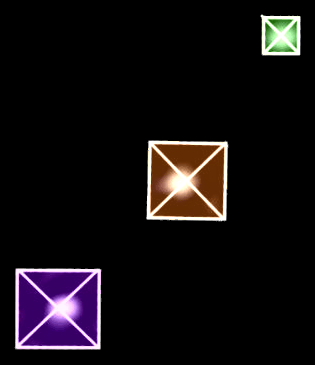 |
...in a curiously twisted manifestation of irony,
the above images are not "in public domain"
...so, i may even get into a little bit of trouble
just for posting them here, on this webpage...
(even though i made em just a little bit nicer)
|
|
|
the left image is, however...
"in public domain" officially
i got it from Wiki's OCT page
and color added, for continuity
...as is generally, on this site...
G1 = purple
G2 = orange
G3 = green
|
|
|
|
|
|
vastly differentiated natural phenomena
...and... these stars, in particular...
hundreds of light years from each other
|
distant from us, in more of a straight line:
with their counterparts Betelgeuse and Rigel
like mile-markers, but with big bright stars
|
here's a list of these stars
(and more) type and distance
in light years... from us...
|
|
|
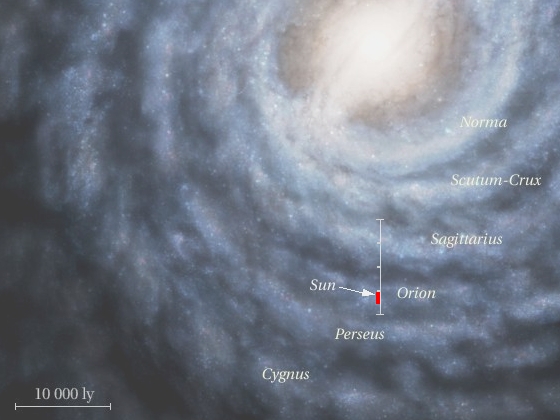 |
gal cen 26,000 black hole
Antares 600 SUPERGIANT
Sirius 9 sub-giant
Procyon 11 sub-giant
Pollux 33 Giant
Castor 52 multiple
Aldebaran 65 Giant
Bellatrix 240 Giant
Betelgeuse 430 SUPERGIANT
Pleiades 440 cluster
Saiph 720 SUPERGIANT
Rigel 770 SUPERGIANT
ALNITAK 820 SUPERGIANT
MINTAKA 920 Bright Giant
Meissa 1060 Bright Giant
ALNILAM 1300 SUPERGIANT
Trapezium 1600 cluster
|
|
|
left image: "Map of the Milky Way" from:
atlasoftheuniverse.com/milkyway.html
|
extrapolating from the given scale legend
i've added in local definition (red band)
as an approximate 13,600 light year strip
(and it's not exact but you get the idea)
definining approximately the entire width
of the Orion Arm (our local neighborhood)
...which we are about in the middle of...
so, obviously named for the constellation
and i'm guessing this is why: these stars
|
|
|
|
|
 |
...this continues on the other side of our sky
with Antares in Scorpio toward galactic center
forming a kind of cross section of the galaxy,
which is about 100,000 light years in diameter
(our position being about 2/3 out from center)
(but then again, that's just the bright stuff)
|
Meissa and Bellatrix
are both Blue Giants
(but not Supergiants
as are all the rest)
not as big or bright
(to us... from them)
|
but just beyond our modern constellation Orion
there are several other stars... bright enough
to merit similar attention (and consideration)
...and not very far at all... and prominent...
and perhaps the most famous objects in the sky
are the Pleiades, aka the Seven Sisters (left)
...which, there's actually hundreds of them...
Atlas, Alcyone and Melrope (on the lower left)
Maia and Electra (bright, on right)... so five
|
the Pleiades, rotated
and superimposed over
the GPMP map (below):
the 3 left or eastern
stars: Atlas, Alcyone
and Melrope (left)...
and the 3 north stars
or upper-most (right)
Atlas, Alcyone & Maia
|
|
|
|
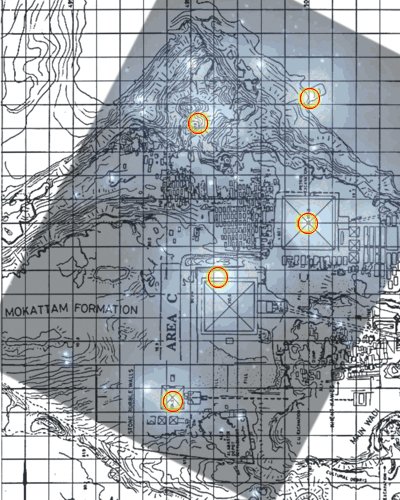 |
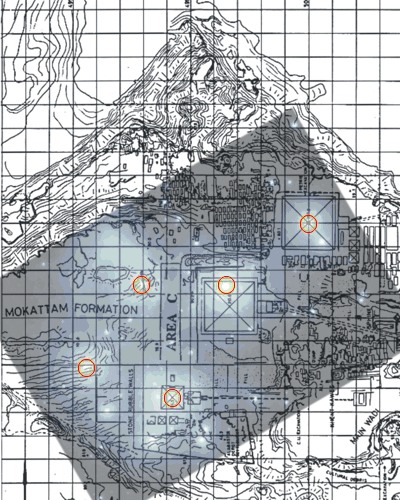 |
above left: Atlas on G3 and Melrope on G1
...Alcyone is right on the north edge of G2...
half way between center and the NW corner
...with Maia and Electra almost barely aligning
to some topographical features: a prominent hill
...and a natural peninsula on the old Nile shore...
|
above right: with Atlas on G1 and Maia on G3
Alcyone is, again, right on the north edge of G2
...just ever so slightly west of exact center...
and with Melrope and Electra right in the middle
of separate wide downward slopes off to the west
(other minor stars in both of these bear notice)
|
and not really taking any of this seriously, but the proportion of these scales = approximately Phi
so, wouldn't it be the wiggiest thing known to all mankind if it was also aligned to the Pleiades ?
|
|
|
|
